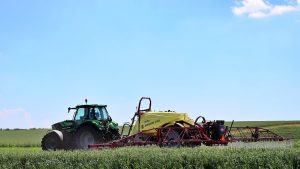
Despite their efficiency and effectiveness, boom sprayers also come with notable disadvantages that can impact their performance, cost-efficiency, and environmental footprint.
Below, we explore these drawbacks in detail to provide a comprehensive understanding of the challenges associated with using boom sprayers.
What Are The Disadvantages Of A Boom Sprayer? Complete Guide
1. High Initial Cost
Boom sprayers require a significant initial investment compared to simpler sprayers like backpack or hand-operated models. Their advanced features, large capacity, and precise application systems make them expensive to purchase. For small-scale farmers, this cost can be prohibitive.
2. Maintenance Complexity and Cost
Boom sprayers consist of intricate components such as pumps, nozzles, and control systems. Maintaining these parts requires regular servicing, specialized knowledge, and spare parts, which add to operating expenses. Failures in components like nozzles or spray booms can halt operations and lead to costly repairs.
3. Potential for Drift
One of the most critical disadvantages of boom sprayers is spray drift. High winds, improper calibration, or low-quality nozzles can cause chemicals to disperse beyond target areas, potentially harming non-target crops, wildlife, and nearby water bodies. This not only reduces efficiency but also raises environmental concerns.
4. Uneven Coverage on Uneven Terrain
Boom sprayers are most effective on flat or gently sloping terrain. On uneven or hilly fields, maintaining uniform spray coverage can be challenging. Uneven terrain may cause the spray booms to move erratically, leading to inconsistent chemical application.
5. Size and Maneuverability Limitations
Due to their large size, boom sprayers are less maneuverable in smaller fields or areas with obstacles such as trees and fences. This makes them unsuitable for farms with complex layouts, limiting their utility in such scenarios.
6. Dependence on External Power Sources
Boom sprayers are often powered by tractors or other machinery, which increases fuel consumption and operating costs. This dependence on external power sources also limits their usability in areas without access to compatible machinery.
7. Environmental Impact
The use of boom sprayers can contribute to environmental degradation through chemical overuse or misuse. Drift, runoff into water sources, and over-application can harm ecosystems, contaminate groundwater, and pose risks to human health.
8. Calibration Challenges
Achieving optimal performance requires precise calibration of the spray nozzles, boom height, and operating pressure. Improper calibration can result in over-application or under-application, both of which reduce efficiency and may damage crops or leave them vulnerable to pests and diseases.
9. Sensitivity to Weather Conditions
Boom sprayers are heavily influenced by environmental factors. Wind, temperature, and humidity affect the dispersion and effectiveness of sprays. Operations may need to be postponed during adverse weather conditions, leading to delays.
10. Heavy Weight
The substantial weight of boom sprayers can compact soil, particularly when used repeatedly on the same field. Soil compaction reduces aeration and water infiltration, ultimately impacting crop yields.
11. Skill Requirements
Operating a boom sprayer effectively requires training and experience. Misuse or lack of understanding of its controls and features can lead to inefficiencies, safety risks, and equipment damage.
12. Limited Applicability for Small Farms
For small-scale farms, the large size and capacity of boom sprayers may be excessive. Farmers with smaller fields may find other spraying solutions more practical and cost-effective.
What Are The Disadvantages Of A Boom Sprayer FAQs
- Why are boom sprayers expensive?
- Boom sprayers involve advanced technologies, high-capacity tanks, and precise application systems, making them costlier than simpler sprayers.
- How can spray drift be minimized?
- Use high-quality nozzles, maintain proper boom height, and avoid spraying during windy conditions to reduce drift.
- Are boom sprayers suitable for hilly terrain?
- They are less effective on uneven terrain due to difficulties in maintaining consistent spray coverage.
- What maintenance is required for boom sprayers?
- Regular cleaning, nozzle checks, and pump servicing are essential to ensure proper functioning.
- How does weather impact boom sprayers?
- Wind, humidity, and temperature influence spray dispersion and effectiveness, often delaying application.
- Can boom sprayers be used on small farms?
- While possible, their size and cost may not be justified for small-scale operations.
- What are alternatives to boom sprayers?
- Backpack sprayers, handheld sprayers, and air-assisted sprayers are better suited for smaller fields or specific tasks.
Conclusion
While boom sprayers are undeniably valuable for large-scale agricultural operations, their disadvantages must be carefully considered.
Factors such as cost, environmental impact, and operational limitations highlight the need for proper planning and responsible usage.
Farmers should weigh the pros and cons based on their specific requirements to make informed decisions about whether a boom sprayer is the right choice for their farm.
Recent Posts
Benin Coup Bombshell Soldiers Announce Seizure Of Power On National TV
On 7 December 2025, soldiers in Benin appeared live on national television and announced that they had seized power from the country’s elected government. The announcement shocked the nation and...
Snowfall patterns across the United States vary wildly, with northern regions regularly blanketed in white while southern states often go years without a single flake. Because of this variability,...